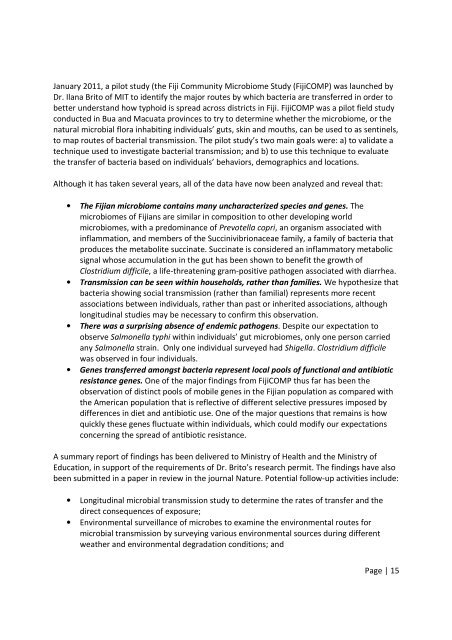FIJI COUNTRY PROGRAM 2015
2015_annual_report_20151214
2015_annual_report_20151214
Create successful ePaper yourself
Turn your PDF publications into a flip-book with our unique Google optimized e-Paper software.
January 2011, a pilot study (the Fiji Community Microbiome Study (FijiCOMP) was launched by<br />
Dr. Ilana Brito of MIT to identify the major routes by which bacteria are transferred in order to<br />
better understand how typhoid is spread across districts in Fiji. FijiCOMP was a pilot field study<br />
conducted in Bua and Macuata provinces to try to determine whether the microbiome, or the<br />
natural microbial flora inhabiting individuals’ guts, skin and mouths, can be used to as sentinels,<br />
to map routes of bacterial transmission. The pilot study’s two main goals were: a) to validate a<br />
technique used to investigate bacterial transmission; and b) to use this technique to evaluate<br />
the transfer of bacteria based on individuals’ behaviors, demographics and locations.<br />
Although it has taken several years, all of the data have now been analyzed and reveal that:<br />
• The Fijian microbiome contains many uncharacterized species and genes. The<br />
microbiomes of Fijians are similar in composition to other developing world<br />
microbiomes, with a predominance of Prevotella copri, an organism associated with<br />
inflammation, and members of the Succinivibrionaceae family, a family of bacteria that<br />
produces the metabolite succinate. Succinate is considered an inflammatory metabolic<br />
signal whose accumulation in the gut has been shown to benefit the growth of<br />
Clostridium difficile, a life-threatening gram-positive pathogen associated with diarrhea.<br />
• Transmission can be seen within households, rather than families. We hypothesize that<br />
bacteria showing social transmission (rather than familial) represents more recent<br />
associations between individuals, rather than past or inherited associations, although<br />
longitudinal studies may be necessary to confirm this observation.<br />
• There was a surprising absence of endemic pathogens. Despite our expectation to<br />
observe Salmonella typhi within individuals’ gut microbiomes, only one person carried<br />
any Salmonella strain. Only one individual surveyed had Shigella. Clostridium difficile<br />
was observed in four individuals.<br />
• Genes transferred amongst bacteria represent local pools of functional and antibiotic<br />
resistance genes. One of the major findings from FijiCOMP thus far has been the<br />
observation of distinct pools of mobile genes in the Fijian population as compared with<br />
the American population that is reflective of different selective pressures imposed by<br />
differences in diet and antibiotic use. One of the major questions that remains is how<br />
quickly these genes fluctuate within individuals, which could modify our expectations<br />
concerning the spread of antibiotic resistance.<br />
A summary report of findings has been delivered to Ministry of Health and the Ministry of<br />
Education, in support of the requirements of Dr. Brito’s research permit. The findings have also<br />
been submitted in a paper in review in the journal Nature. Potential follow-up activities include:<br />
• Longitudinal microbial transmission study to determine the rates of transfer and the<br />
direct consequences of exposure;<br />
• Environmental surveillance of microbes to examine the environmental routes for<br />
microbial transmission by surveying various environmental sources during different<br />
weather and environmental degradation conditions; and<br />
Page | 15


